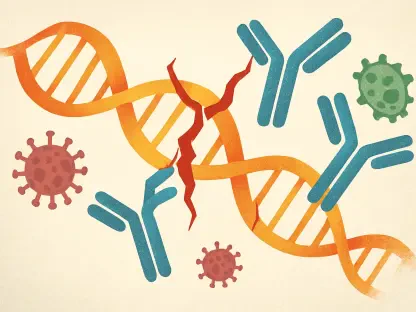Imagine unlocking a code that holds the secret to the myriad complexities of brain evolution and the onset of neurological diseases. This concept has come closer to reality with a pivotal study led by a Belgian research team, which delves deep into the genetic regulatory codes that control brain cell functions across different species. By exploring the genetic switches that regulate gene activity, the study aims to define the unique characteristics and behaviors of brain cell types in humans, mice, and chickens. These regulatory codes ensure that each cell type interprets genetic instructions correctly, allowing it to perform its distinct role within the brain.
With recent advances in deep learning models, the researchers trained their systems to analyze brain data from these species. This helped them discover fascinating insights into the conservation and divergence of brain cell types over millions of years. Interestingly, they found that certain neurons in birds have similar regulatory codes to those in the mammalian neocortex, despite the differences in their neuroanatomy. This discovery is crucial for understanding how genetic regulation affects brain cell evolution.
Understanding Brain Evolution through Genetic Codes
By focusing on the regulatory code, researchers can unveil significant insights into the shared and divergent evolutionary pathways among different species. This study highlighted that while some brain cell types have remained highly conserved throughout evolutionary history, others have evolved uniquely across different species. For example, the team found striking similarities in the regulatory codes of certain bird neurons and deep-layer neurons in the mammalian neocortex. Despite the vast anatomical differences in their brains, these neurons share a genetic blueprint that underscores a common evolutionary thread.
The implications of these findings extend to our understanding of gene regulation’s role in shaping brain cell functions and behaviors. By analyzing how these regulatory codes influence the evolution of brain cell types, researchers can better comprehend the intricate mechanisms underpinning brain diversity. Moreover, this study emphasizes the importance of genetic regulatory codes in dictating brain cell behaviors, offering a clearer picture of the evolutionary processes that have molded brain structures across species. The ability to analyze these genetic patterns deepens our knowledge of brain complexity and could pave the way for new research avenues.
Impact on Disease Research
In addition to shedding light on brain evolution, the study’s findings have substantial implications for understanding and treating various diseases. The research team, led by Prof. Stein Aerts at VIB and the VIB-KU Leuven Center for Brain & Disease Research, aims to apply the insights gained from genetic regulatory codes to contexts broader than just evolution. The team has developed deep learning methods to comprehend how these codes influence diseases such as cancer and brain disorders. For example, they discovered that regulatory codes influencing melanoma are conserved across mammals and zebrafish, demonstrating the potential to apply these codes to diverse species.
Furthermore, the team’s models on brain cell types provide valuable tools for investigating genomic variants associated with mental or cognitive traits and disorders. By screening genomes for specific cell types’ regulatory codes, researchers can gain a better understanding of the genetic foundations of various conditions. The study potentially identifies how different cell types impact the development and progression of diseases, offering innovative tools for exploring genetic variations related to neurological conditions like Parkinson’s disease.
Moreover, expanding their research scope, Prof. Aerts’ team is collaborating with Zoo Science and Wildlife Rescue Center to analyze brain data from an array of animals, ranging from fish to deer, hedgehogs, and capybaras. This broad approach could reveal much about the genetic variations linked to different brain functions and disorders, ultimately contributing to better diagnostic and therapeutic strategies. By leveraging AI models, researchers can continue to unravel the genetic underpinnings of disease, a pursuit that promises to revolutionize our understanding and treatment of neurological conditions.
Future Prospects and Broader Applications
Imagine deciphering a code that unlocks the secrets of brain evolution and the origins of neurological diseases. This once-farfetched idea is becoming reality thanks to a groundbreaking study by a Belgian research team. The researchers are delving deep into genetic regulatory codes that oversee brain cell functions across various species. By examining the genetic switches that control gene activity, the study aims to delineate the unique traits and behaviors of brain cell types in humans, mice, and chickens. These regulatory codes ensure that every cell type accurately interprets genetic instructions, enabling it to fulfill its distinct role within the brain.
Leveraging recent advancements in deep learning models, the team trained their systems to analyze brain data from these species. Their efforts unveiled intriguing insights into the conservation and divergence of brain cell types over millions of years. Remarkably, they discovered that certain neurons in birds have regulatory codes similar to those in the mammalian neocortex, despite anatomical differences. This finding is vital for comprehending how genetic regulation influences brain cell evolution.









